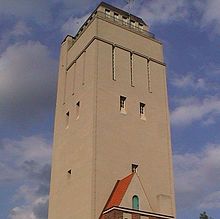- Delmenhorst
-
Delmenhorst 
Coordinates 53°03′2″N 8°37′54″E / 53.05056°N 8.63167°ECoordinates: 53°03′2″N 8°37′54″E / 53.05056°N 8.63167°E Administration Country Germany State Lower Saxony District Urban district Lord Mayor Patrick de La Lanne Basic statistics Area 62.36 km2 (24.08 sq mi) Elevation 7 m (23 ft) Population 74,361 (31 December 2010)[1] - Density 1,192 /km2 (3,088 /sq mi) Other information Time zone CET/CEST (UTC+1/+2) Licence plate DEL Postal codes 27747, 27749, 27751, 27753,27755 Area code 04221 Website www.delmenhorst.de Delmenhorst (German pronunciation: [ˈdɛlmənhɔʁst]) is an urban district (Kreisfreie Stadt) in Lower Saxony, Germany. It has a population of 74,500 and is located 10 km/6 miles west of downtown Bremen with which it forms a contiguous urban area, whereas the city of Oldenburg is 25 km/15 miles to the northwest. The city has a total area of 62.36 km² and a population density of approx. 1200 inhabitants per km².
Since 2006 it is governed by the mayor Patrick de la Lanne.
Contents
History
Delmenhorst was first mentioned in a charter in the year 1254, after the Count of Oldenburg, Otto I, bought the place near the river Delme in 1234. A castle to protect the newly founded settlement was established in about 1247. The following count, Otto II, made the castle his residency; Delmenhorst was declared an independent town on 15 July 1371 under Bremen's law.
After a short period under the governance of the bishop of Bremen from 1421 to 1436 Delmenhorst returned under the custody of Oldenburg. Delmenhorst later was infamous for its robber-baronship under the count Gerd. Its reign ended in 1482 thanks to a siege laid to the castle under the leadership of the bishop of Münster. Therefore the town now was under Münster authority until finally count Anton I won back the town as well as the castle in 1547.
When the last heir of Anton, Christian, died in 1647, Delmenhorst again fell under Oldenburg custody. As the Oldenburg regent of that time was a relative of the Danish king, Delmenhorst was thereafter under Danish control.
In 1767 Delmenhorst was bought by Tsarina Katharina II, but was given up to Oldenburg in 1773. In 1777 Delmenhorst was declared a dukedom of Oldenburg. In 1806 a French and Dutch army occupied the territory; Delmenhorst was a part of the French empire under Napoleon from 1811 to 1813.
In the industrial age Delmenhorst experienced a great economical growth, thanks to Bremen. Since Bremen was in a different duty zone, merchants who wanted to export manufactured goods outside of Bremen had to pay high customs duties. They therefore only exported the resources and produced their commodities in the surrounding villages. The industries arising were the Jute - a spinning works and weavery in 1871, the Delmenhorster Linoleumfabrik - a linoleum factory, in 1882, the Norddeutsche Wollkämmerei und Kammgarnspinnerei or Nordwolle - another, bigger spinning works, and several others. The number of inhabitants quadrupled in these years.
In 1903 Delmenhorst was declared kreisfrei, meaning it was under its own regentship, not having to obey any other county. In the 1930s Great Depression the Nordwolle went bankrupt - nevertheless the town grew bigger, incorporating several smaller villages around it. On Kristallnacht in November 1938 the synagogue was burnt down by the Nazis which had came to power in Germany in 1933. After the Second World War Delmenhorst was in the British zone of occupation and had to deal with thousands of refugees from Eastern Germany, which now was occupied by the Soviet Union. The British-appointed mayor during the British Occupation was Major Jack Wolfe, an inspector of the British Constabulary. In 1950, more than 57,000 people lived in Delmenhorst.
Since the 1960s there has been a steady decrease in employment, leaving more than 13% of the town's inhabitants unemployed and nearly 7% living on social welfare. In the year 2000 Delmenhorst was an outpost of the Hanover-based Expo 2000.
Main sights
The landmark of the town is complex of the watertower with the adjacent Town Hall, built from 1910 to 1914 by architect Heinz Stoffregen.
Another interesting place is the Burginsel (Castle Island), in which the old castle existed in medieval times. The construction was torn off during the 18th century. Today a park (called the Graft) occupies the grounds of the old castle.
The industrial history of the town is presented by the Nordwolle Museum, an Anchor Point of ERIH, The European Route of Industrial Heritage.
Twin cities
 – Allonnes, France
– Allonnes, France – Borisoglebsk, Russia
– Borisoglebsk, Russia – Eberswalde, Germany
– Eberswalde, Germany – Kolding, Denmark
– Kolding, Denmark – Lublin, Poland
– Lublin, Poland – Toledo, Ohio, United States
– Toledo, Ohio, United States
References
- ^ "Bevölkerungsfortschreibung" (in German). Landesbetrieb für Statistik und Kommunikationstechnologie Niedersachsen. 31 December 2009. http://www1.nls.niedersachsen.de/statistik/html/parametereingabe.asp?DT=K1000014&CM=Bev%F6lkerungsfortschreibung.
External links
- (German) Delmenhorst Homepage
- (German) webcam providing a view over the market place from the top of the town hall
- (German) Search in the Delmenhorster Bibliography (the total bibliography as PDF (461 kB))
 Urban and rural districts in the state of Lower Saxony in Germany
Urban and rural districts in the state of Lower Saxony in Germany 
Region HanoverUrban districts Rural districts Ammerland · Aurich · Bentheim · Celle · Cloppenburg · Cuxhaven · Diepholz · Emsland · Friesland · Gifhorn · Goslar · Göttingen · Hamelin-Pyrmont · Harburg · Heidekreis · Helmstedt · Hildesheim · Holzminden · Leer · Lüchow-Dannenberg · Lüneburg · Nienburg · Northeim · Oldenburg · Osnabrück · Osterholz · Osterode · Peine · Rotenburg · Schaumburg · Stade · Uelzen · Vechta · Verden · Wesermarsch · Wittmund · WolfenbüttelCategories:- Towns in Lower Saxony
Wikimedia Foundation. 2010.



